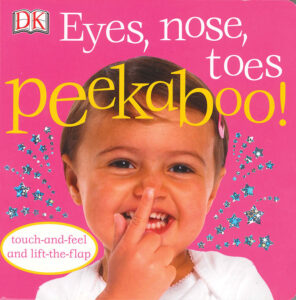Receptive language, Expressive language
Toddlers participate in a book sharing focused on body parts.



[Invite several toddlers to share a book. Show the cover of the book. Point to the picture on the cover as you introduce the book.]
There is a picture of a baby on the cover of our book. This is the picture. Here is the baby.
 [Point to the nose of the pictured baby.]
[Point to the nose of the pictured baby.]
Here is the baby’s nose. Each of us has a nose!
Let’s all point to our nose!
[Gently point to your nose and invite toddlers to point to their nose. Describe what toddlers are doing. Example: “We are pointing to our nose!”]
Our nose is part of our body. Our book is about parts of a body.
[Open the book, hold it so each toddler can see the book’s pictures, and use the following strategies to engage toddlers in the book.
[Describe what happened during the book sharing. Example: “We looked at pictures of babies and their toys. We pointed to their eyes, and ears, and toes! These are parts of a body. We touched the teddy bear’s nose. It felt soft.”]
Toddlers will likely enjoy looking at the book’s pictures of babies and their toys. This book uses the familiar game of Peekaboo to strengthen awareness of the names of body parts. Lifting the flaps to reveal a picture adds an element of anticipation to the peekaboo routine. This book also provides the opportunity to touch and feel the pictures underneath the flaps. Depending on the size of your gathering and time available, you may wish to limit the number of pictures that toddlers feel, or use a one-to-one setting (Option 2) for the sensory element of the book.
Extra support
Enrichment
Receptive language, Expressive language
A toddler participates in a book sharing that includes opportunities to point to body parts and feel different textures provided in the book.



 Invite a toddler to join you in reading a book about different parts of a body. Show the book cover and explain that the babies in the pictures are playing Peekaboo with their toys. Combine the book’s text with your own words to describe pictures. Use the following approach to sharing the book:
Invite a toddler to join you in reading a book about different parts of a body. Show the book cover and explain that the babies in the pictures are playing Peekaboo with their toys. Combine the book’s text with your own words to describe pictures. Use the following approach to sharing the book:
The one-to-one setting offers opportunities for the toddler to be highly active in sharing the book with you. This book, in particular, has many participation options, including lifting flaps, engaging in peekaboo, and feeling textures included in the book. Encouraging a toddler to find and point to his/her corresponding body parts at the end of the book will help strengthen connections between pictures and a toddler’s developing knowledge.
Toddlers are likely to participate in this activity in different ways. Some may be interested in looking closely at the body parts of the pictured babies, whereas others may delight in finding the corresponding parts of the toys revealed under the flaps. Some toddlers may vocalize a version of the word “peekaboo” or the name of a familiar body part, such as eyes or nose.
Extra support
Enrichment
Materials Needed: Eyes, Nose, Toes Peekaboo! by DK Publishing, several toys pictured in the book (such as a doll, teddy bear, or bunny)
Arrange the book and toys on a low table. Invite several toddlers to touch and hold the toys. Review the book with toddlers, emphasizing the body parts of the babies and pictured toys. Invite toddlers to find the corresponding part on the toys. Reinforce the toddler’s accurate pointing. Example: “The doll in our book has eyes. You are touching the doll’s eyes, Mia.”
Materials Needed: Eyes, Nose, Toes Peekaboo! by DK Publishing
This book can be shared with children of different ages in your setting. Invite children to help you “read” the book by saying “peekaboo” at the appropriate time on each page. Encourage toddlers and older children to point to their own corresponding body parts during the book sharing. After the book, invite the children to sing a song with body parts, such as “Head, Shoulders, Knees and Toes.” Sing one verse slowly, helping toddlers to point to their eyes, ears, nose, and mouth during the song.